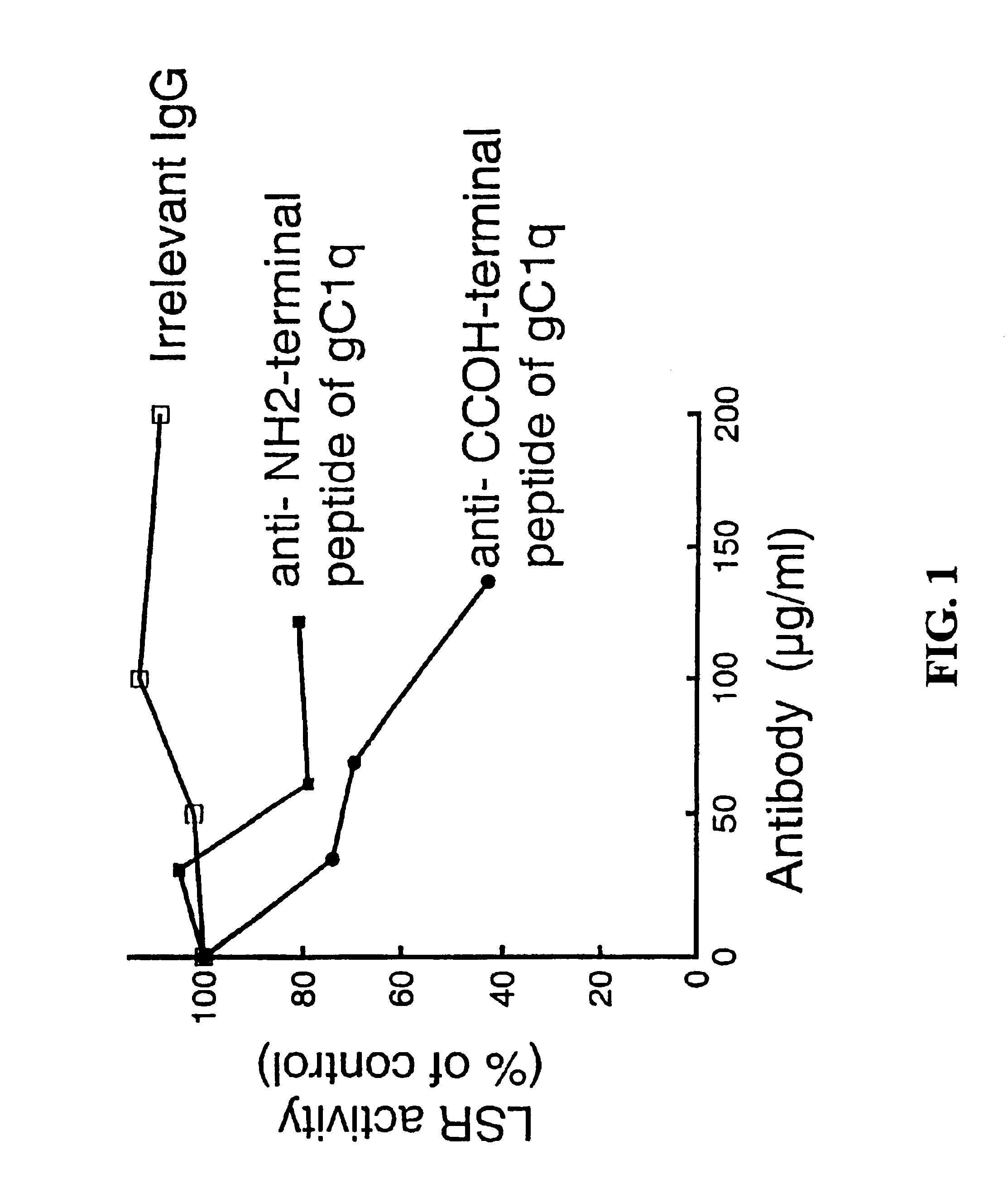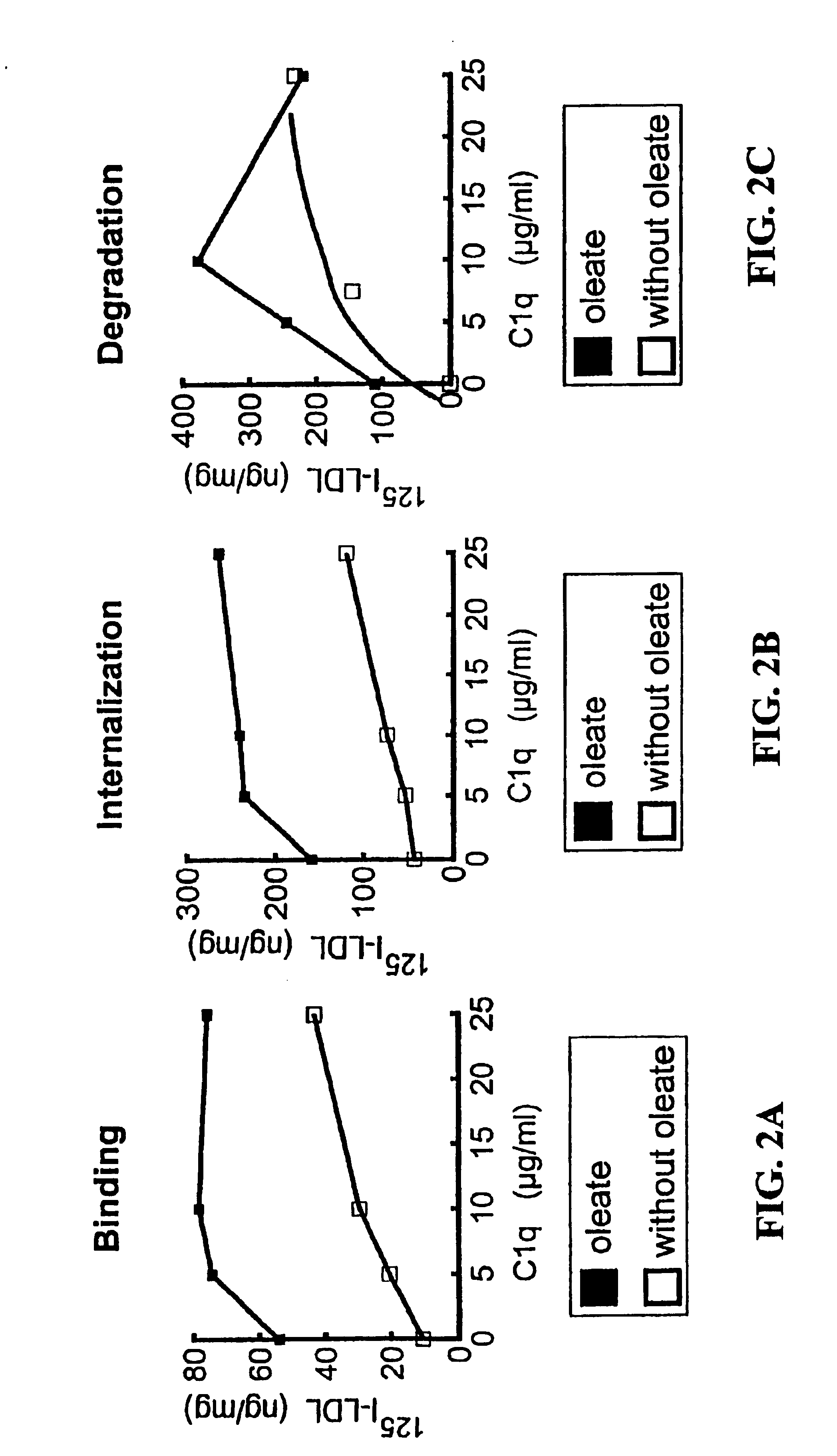Lipoprotein-regulating medicaments
- Summary
- Abstract
- Description
- Claims
- Application Information
AI Technical Summary
Benefits of technology
Problems solved by technology
Method used
Image
Examples
example 1
The gC1q-R or a gC1q-R-like Protein is a Component of the Multi-subunit LSR
[0123]Rabbit polyclonal antibodies directed against two synthetic peptides having sequences located within the carboxy- and amino-terminal ends of the gC1q-R protein were prepared according to standard laboratory procedures. The synthetic peptide representing the N-terminal region of the protein had the sequence, LRCVPRVLGSSVAGY* (SEQ ID NO:3) and corresponded to residues 5-19 of the gC1q-R polypeptide sequence. The C-terminal synthetic peptide had the sequence, C*YITFLEDLKSFVKSQ (SEQ ID NO:4) and corresponded to residues 268-282 of gC1q-R. Amino acid positions marked with “*” indicate residues that differed from the wild type protein sequence in order to enhance peptide antigenicity. Peptides were coupled to a keyhole limpet hemocyacin (KLH) carrier prior to injection into rabbits. These procedures resulted in two serum samples, each with a binding specificity for a different region of the gC1q-R protein. Im...
example 2
Regulation of LSR Activity by C1q and its Homologues
[0129]Primary cultures of rat hepatocytes were incubated with 20 ng of leptin / well using 6-well plates for 30 minutes at 37° C. in order to stimulate mobilization of LSR proteins to the cell surface and to increase the number of LSR receptors expressed. Increasing concentrations of C1q (Sigma) and 20 μg / ml of 125I-LDL were then added to parallel cell cultures in the presence or absence of 0.5 mM oleate. The mixtures were then incubated 4 hours at 37° C. and the binding, internalization and degradation of the labeled LDL analyzed using standard techniques (Bihain et al., Biochemistry 31:4628 (1992); Mann et al., J. Biol. Chem. 272:31348(1997)).
[0130]The results presented in FIGS. 2A-C unexpectedly indicated that C1q enhanced LSR activity both in the presence and absence of free fatty acids. Indeed, it was surprising that lipoprotein binding, internalization and degradation occurred in the absence of added oleate because these aspect...
example 3
Construction of an Expression Vector Encoding Murine AdipoQ
[0140]Standard laboratory procedures were used to isolate RNA from adipose tissue that had been obtained from C57BL / 6J mice. Poly(A)* mRNA was captured using oligo-dT coated magnetic beads according to the manufacturer's instructions (Dynal, France). The mRNA was reverse transcribed into cDNA using SUPERSCRIPT reverse transcriptase and reagents that were purchased as a kit (Life Technologies, France). cDNA encoding AdipoQ was amplified in a standard PCR protocol using oligonucleotide primers having the sequences: CTACATGGATCCAGTCATGCCGAAGAT (SEQ ID NO:5), and CGACAACTCGAGTCAGTTGGTATCATGG (SEQ ID NO:6). This procedure selectively amplified polynucleotide sequences downstream of the putative signal sequence located at the 5′ end of the AdipoQ coding region. The amplified cDNA was digested with BamHI and Xhol restriction endonucleases and the digestion products ligated into the corresponding sites of the pTRC His B expression v...
PUM
| Property | Measurement | Unit |
|---|---|---|
| Electrical resistance | aaaaa | aaaaa |
Abstract
Description
Claims
Application Information
 Login to View More
Login to View More - R&D
- Intellectual Property
- Life Sciences
- Materials
- Tech Scout
- Unparalleled Data Quality
- Higher Quality Content
- 60% Fewer Hallucinations
Browse by: Latest US Patents, China's latest patents, Technical Efficacy Thesaurus, Application Domain, Technology Topic, Popular Technical Reports.
© 2025 PatSnap. All rights reserved.Legal|Privacy policy|Modern Slavery Act Transparency Statement|Sitemap|About US| Contact US: help@patsnap.com



